Microplastics in Gum
Published June 18, 2025.
A group of UCLA researchers found that chewing gum can expose you to thousands of microplastics. The team tested five common brands of synthetic gum and five common brands of natural gum. One subject chewed seven pieces of gum for all 10 brands to repeat the experiment with the same chewing pattern and saliva. The team measured an average of 100 microplastics released per gram of gum. Since most gum weighs between 2 to 6 grams, a large piece could release as much as 3,000 microplastics.
The researchers were surprised to find that both synthetic and natural gums released similar amounts of microplastics and contained the same polymers: polyolefins, polyethylene terephthalates, polyacrylamides and polystyrenes. Natural gums come from chicle and other tree saps while synthetic gums use petroleum compounds as their base, which makes the findings unexpected.
The researchers also discovered that most of the microplastics were released from the gum within the first 2 minutes of chewing. The researcher suggested that chewing the same piece of gum for longer could expose you to less microplastics than chewing a new piece. Based on their calculations, chewing one piece of gum every other day could expose you to 30,000 microplastics a year.
The author said their goal is not to alarm anybody since scientists don’t know if microplastics are unsafe to us or not because of a lack of human trials. This goes to show that at the end of the day, we have to look out for our own health.
Subscribe to My Health Forward

Browse My Heirloom Seeds
I carry over 170 varieties of heirloom seed packets that are open-pollinated, non-gmo, pesticide-free, and breed true to type. Growing your own produce provides you with continual access to healthy and nutritious food.

Find Local Farms
Find farms near you using my map with over 6,500 local farms, ranches, markets, and stands across the country.
